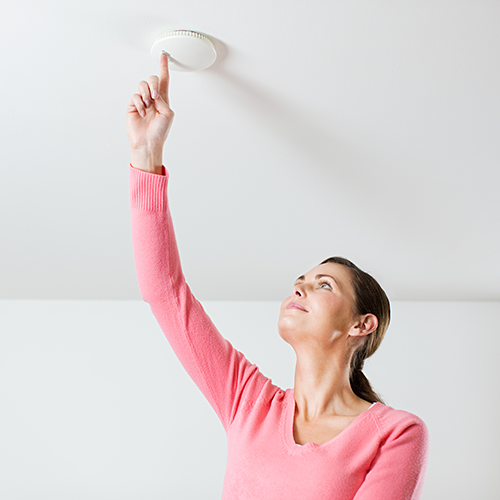By: Dex Tuttle, injury prevention program manager at Children’s Minnesota, and Capt. Casidy Anderson, community risk reduction officer with Minneapolis Fire Department.
There are two ways to read the title of this blog, one: Choosing as in, “Yes, I choose to have a working smoke and carbon monoxide alarms!”; and two: Choosing, in the sense of selecting alarms from the rows of choices available at the store or online.
If you’ve already chosen the first option – having working smoke and carbon monoxide alarms in your home – then congratulations! You’ve taken the first, and most important, step in preventing smoke, fire and carbon monoxide-related injury and death in your home. If you need some advice on choosing which alarm is best for you, then you’re in the right place.
What is carbon monoxide and why is it dangerous?
Carbon monoxide is a gas that you can’t see, taste or smell that is released from fires, like the ones that are possibly in your furnace or heaters. This is why it’s important that vents and exhaust pipes are clean and clear so the gas can escape your home. If it gets stuck in your house, it can make you feel sleepy, give you bad headaches, make you dizzy, confused or give you nausea, shortness of breath, confusion or cause you to lose consciousness.

The gas that’s released is made of carbon and oxygen, so that’s why you often see it abbreviated as “CO.”
Why is it important to have smoke and carbon monoxide alarms in your home?
Smoke and CO alarms save lives. It’s a fact. And it’s imperative that every home have working smoke and CO alarms.
You should have a smoke alarm within 10 feet of every sleeping area and on every level of your home. “Sleeping area” is defined simply as any area where someone sleeps. For example, if someone is sleeping in the living room on the couch, or you’re hosting a child sleep-over in the basement on the floor, you should have a CO alarm installed within 10 feet of those areas.
According to the National Fire Protection Association, approximately 40 percent of home fire deaths occur in homes with no smoke alarms, and another 20 percent in homes with no working smoke alarms.
Reasons smoke alarms might not work properly
- The battery in your alarm may not be strong enough. A smoke alarm will chirp periodically when the battery is losing charge. A good way to remember: Each time the clock changes for Daylight Savings Time, change your batteries in all of your smoke and CO alarms.
- The alarm may not be in the proper location. There should be an alarm near areas where you cook, sleep and you should have at least one on every level of your home.
- The alarm is expired. The parts inside the alarm that detect smoke and CO might wear out over time. Check your alarms, but generally, they expire in about 10 years.
- In rare cases, an alarm might be defective. If you suspect this, call the manufacturer at the number on the back of the alarm. They will often replace your alarm for free if has not expired.
Note that some alarms may have batteries that can’t be changed — so all you need to do is replace the alarm when it expires—and some are plugged in to a wire in your ceiling, which usually means that they get their energy from your home’s power. When replacing them, make sure you get an alarm that will plug into the same wire.
Shopping for smoke and CO alarms
When shopping for smoke and CO alarms, there are a lot of options to choose from: Different brands, different combinations of sensors (strictly smoke, strictly CO or a combination sensor), different energy sources (hard-wired, AA battery, Lithium battery or a combination), different longevity (lasting anywhere from 5-10 years), price range, and more.
So, how do you choose?
- Start with your budget. The price range for both smoke and CO alarms starts at around $7.00.
- As you add longevity, and technology (such as the ones that sync with your smart phone), the prices climb to over $100!
- But remember: The most important thing is not that you have the most expensive alarm, but that you have working alarms throughout your home.
Advice from the Minneapolis Fire Department
Take some advice from Capt. Casidy Anderson, community risk reduction officer with Minneapolis Fire Department:
“Personally, I like a 10-year Lithium battery alarm that has a “hush” button on it. I prefer these because they last 10 years, and I don’t have to worry about changing the battery during that time, and can simply change the whole unit after 10 years. I write the date that it needs to be replaced in marker on the side of the alarm as a reminder. I like the “hush” button, particularly for the alarm near the kitchen, because I can silence it if it sounds due to cooking. The alarm quiets when you press the button and stays silent unless the conditions get worse. It resets to its default sensitivity after a short time. These alarms generally cost around $20 each. Because of the Minnesota law that requires CO alarms within 10 feet of the sleeping areas, I like the combination smoke/CO alarms with a 10-year Lithium battery for the bedrooms and other areas that people might sleep. If all of the bedrooms in your house are close to each other, it’s possible that one CO alarm can be installed and will cover all of them! Pick the alarm that works best for you.”
Remember, some fire departments have smoke and CO alarm programs that provide free alarms to residents in their jurisdictions that need them. Call your local fire department to inquire if they have such a program in your city.